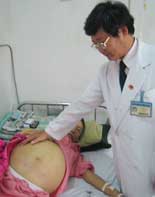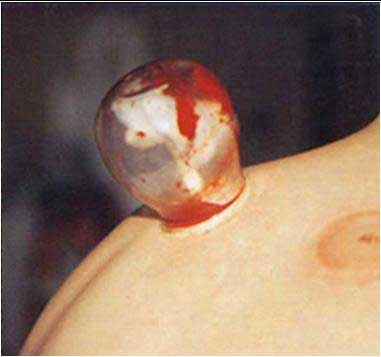In a recent study involving all patients infected with the hepatitis C virus treated both inpatient and outpatient at Chợ Rẫy Hospital, Dr. Bành Vũ Điền, Head of the Hepatitis Department at Chợ Rẫy Hospital, warned that the rate of liver cancer due to hepatitis C is higher and progresses faster compared to hepatitis B.
 |
|
85% of hepatitis C cases will progress to chronic infection. A hepatitis patient being treated at Chợ Rẫy Hospital. (Photo: VNN) |
Currently, in Vietnam, there is only a vaccine for hepatitis B, and no vaccine for hepatitis C exists.
Approximately 15 – 40% of the Vietnamese population is exposed to the hepatitis C virus, with an estimated 85% of hepatitis C cases developing into chronic infection. If left untreated, after 20 – 30 years, 20% of chronic hepatitis cases will progress to cirrhosis and liver cancer.
Hepatitis C: Highly Contagious
In 2005, the Hepatitis Clinic received 1,794 patients with hepatitis C, accounting for 19% of all patients visiting for hepatitis due to other causes.
While only 94 patients out of 4,000 with hepatitis B required hospitalization, over 350 out of 1,794 patients were hospitalized due to severe and permanent liver damage caused by hepatitis C.
In the past, people often overlooked the need for blood tests. However, as the economy has developed, people have become more aware and concerned about their health. Consequently, the rate of hepatitis C detection has increased significantly compared to five years ago.
Nonetheless, as the economy grows, more people are seeking beauty treatments. Individuals visiting beauty salons, especially for procedures like lip and eye tattoos in non-sterile conditions, are at high risk of contracting hepatitis C.
Additionally, patients undergoing long-term dialysis also need to be screened for the hepatitis C virus. Typically, each dialysis patient should use a new filter. However, many facilities must reuse filters due to current conditions. Although sterile techniques can be applied to filters, the prolonged exposure to blood during dialysis increases the risk of hepatitis C transmission.
Subtle Symptoms
In contrast to hepatitis B, most patients with hepatitis C do not exhibit clear symptoms.
Some may experience symptoms similar to those of a cold, such as fatigue, loss of appetite, nausea, flu-like symptoms, weakness, joint pain, and mild abdominal pain.
Less common symptoms may include dark urine, jaundice, and yellowing of the skin. Hepatitis C is often incidentally discovered during routine health check-ups or blood donation.
A person infected with hepatitis C can transmit the virus to others during the first two weeks of infection. Therefore, Dr. Bành Vũ Điền emphasizes the importance of testing. Many people carry the virus in a latent form, and blood tests are the only method for detecting the disease.

In the photo, a person is receiving a back massage to relieve a cold.
This is also a risk factor for hepatitis C infection. (Photo: Dr. B.V. Điền)
Early Detection for Treatment
Hepatitis C can be effectively treated if not yet at the cirrhosis stage.
Most patients discover their hepatitis C infection too late for effective treatment. They often are already at the cirrhosis stage or decompensated cirrhosis (characterized by fluid accumulation in the abdomen and edema).
At this stage, treatment becomes both costly and less effective. In many severe cases requiring a liver transplant, patients may incur costs in the billions without a high success rate, and the disease may recur.
However, according to Dr. Điền, currently, liver transplants for adults in Vietnam cannot be performed in the near future.
“Firstly, this is a very expensive surgery, as post-transplant medication is very costly. Moreover, the Vietnamese Organ Donation Law only allows family members to donate. If one person in the family is ill, the likelihood is that all livers in the family may have issues due to a high risk of transmission,” Dr. Điền explained.
Proper Diet: Reducing Risk to the Liver
The hepatitis C virus causes liver damage.
Generally, the disease progresses gradually over 20 to 30 years, eventually leading to cirrhosis and liver cancer. Many factors influence this process, with diet being the most crucial as all food and drinks are processed by the liver.
From research on hepatitis C patients, Dr. Bành Vũ Điền noted that men over 40 years old had a higher rate of hepatitis C infection. Additionally, those consuming more than 50g of alcohol daily often see the progression of hepatitis C accelerate.
Not only heavy drinkers but also those who consume alcohol socially may suffer liver damage. Instead of the typical 20-30 year timeline for chronic hepatitis to progress to cirrhosis and liver cancer, for regular drinkers, this timeline is reduced to just 5-10 years.
Daily, individuals with chronic liver disease should avoid high iron intake from red meats, organ meats, and should refrain from using iron cookware. A typical diet contains about 10-20mg of iron, with the body absorbing only 1-2mg per day. Excess iron can further damage the liver and diminish the patient’s response during treatment.
Progressive scarring of the liver can lead to abnormal fluid accumulation in the abdominal cavity, resulting in ascites.
If a hepatitis C patient has ascites, just 1mg of salt can lead to an accumulation of 200ml of fluid in the body. Daily salt intake should be less than 1g.
Since the hepatitis C virus often causes a loss of appetite, patients should eat smaller, more frequent meals, drink enough water, and engage in light exercise to improve their appetite and food tolerance. Most importantly, patients must consult with their doctor before starting any diet or exercise program.
Hương Cát


















































